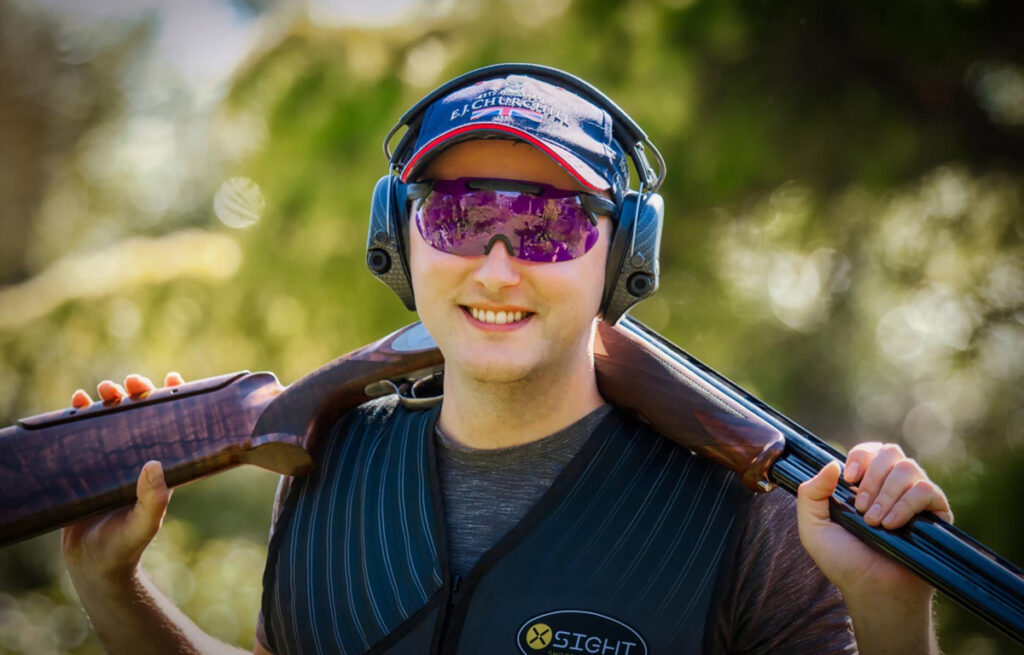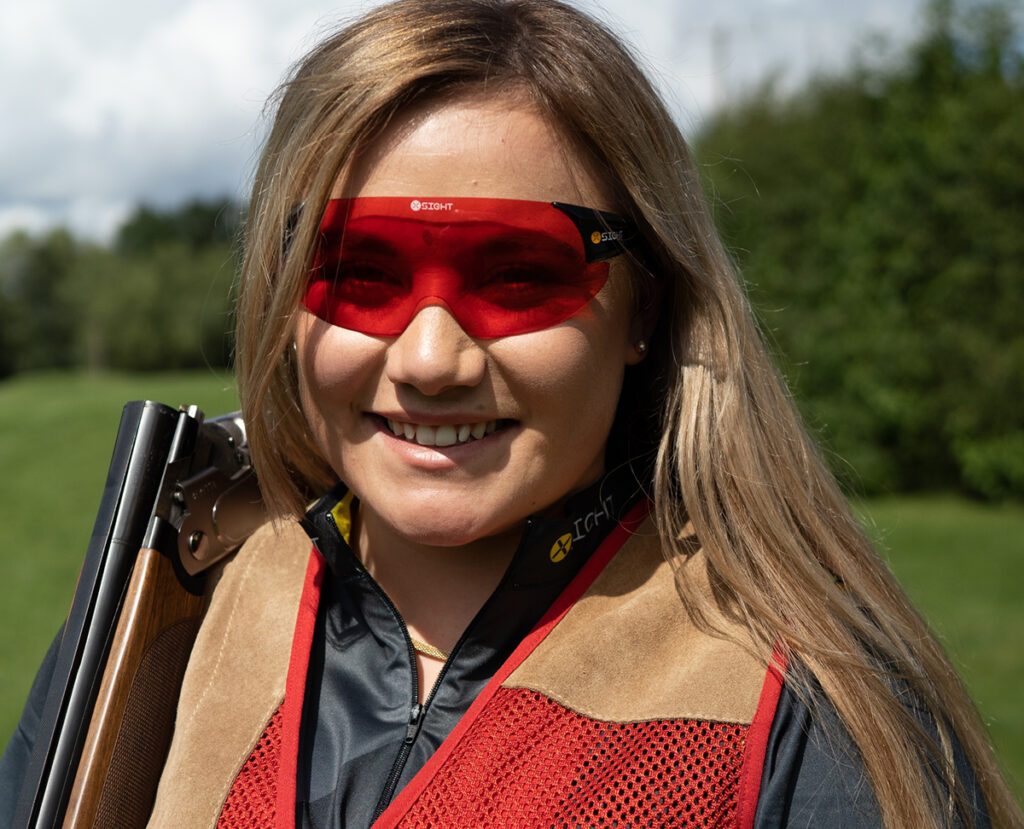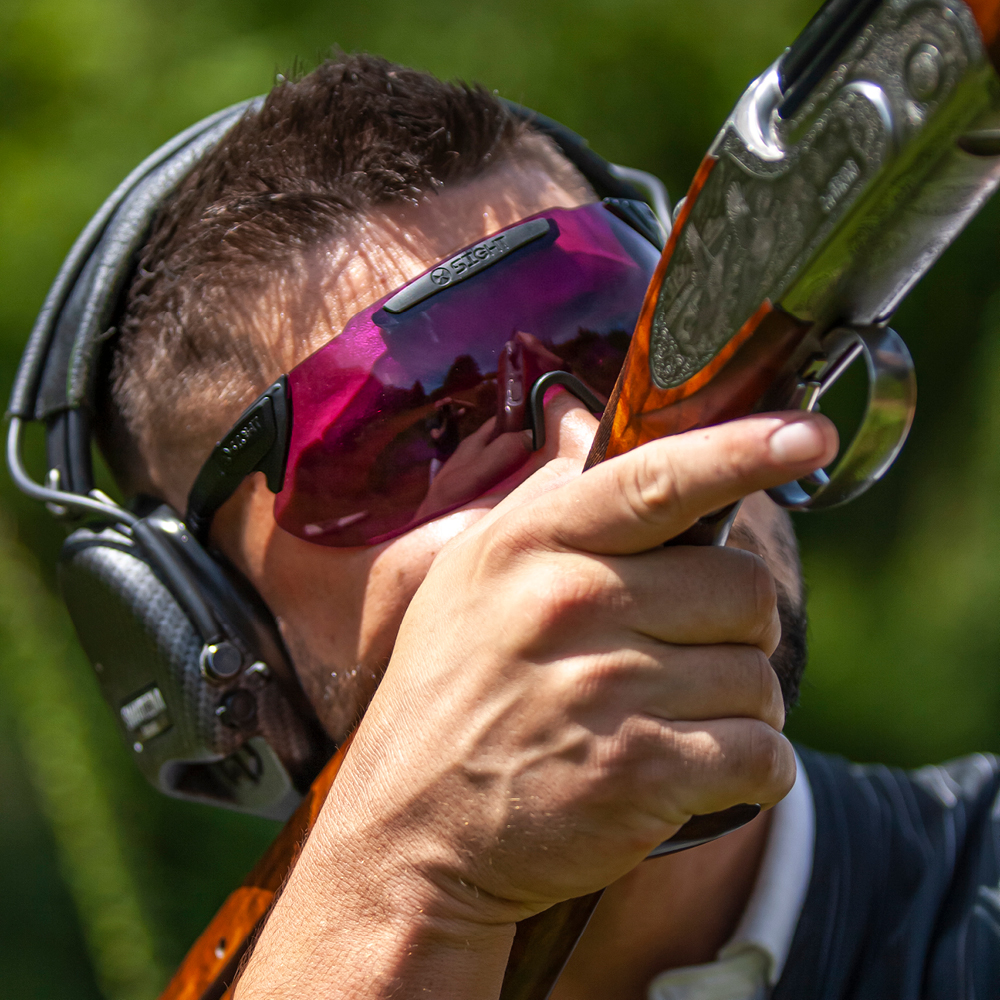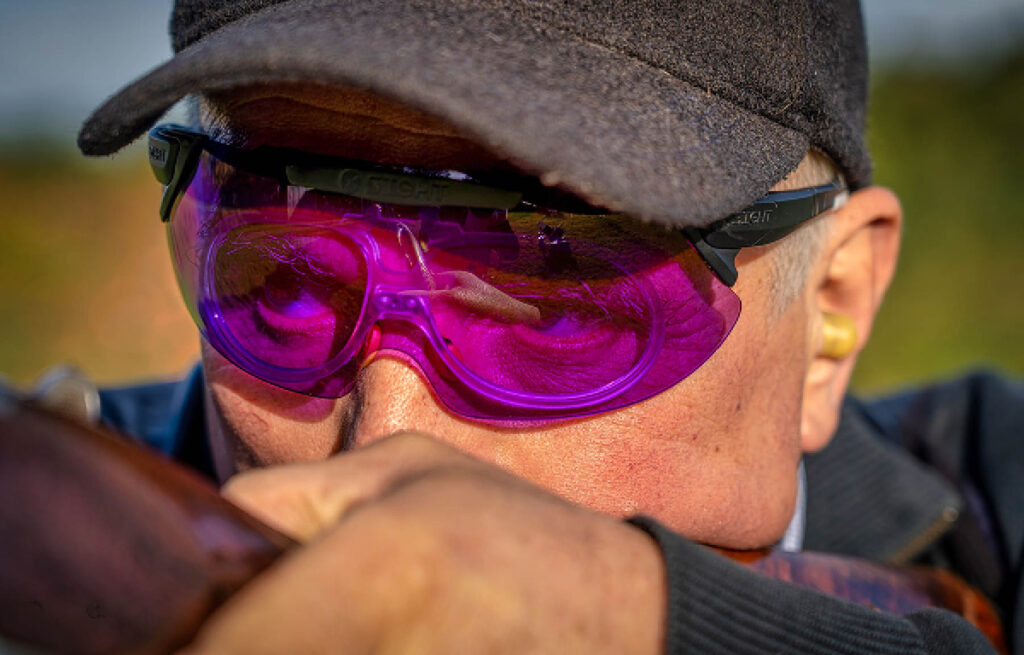
I have been a keen clay shooter for several years and have always had a passion for design and eyewear. When The Country Girls UK asked me if I would write an article about shooting eyewear, I was honoured and jumped at the opportunity.
This blog aims to introduce you to the world of shooting glasses and give you the lowdown on what I think you should look out for and what you need to consider if you are thinking about investing in a set of shooting glasses.
How I became involved in starting up a business for shooting eyewear…
Before I started clay shooting, I was a keen archer. I would attend competitions across the country & managed to get onto the county team. For years I struggled to find one thing that many of us take
for granted. Suitable sunglasses! Almost all sunglasses had nose pads or frames that blocked my line
of sight during aim. As someone who suffers from light sensitivity, the lack of eye protection when shooting long outdoor competitions led to a significant drop in my performance. I wasn’t alone. Nothing on the market worked or offered good performance at an affordable price. It’s for those reasons I started X Sight Sport.
I discovered clay shooting through friends at a local lady guns group in Devon. I was hooked instantly and applied for a license a few months later. It quickly became apparent that the glasses I originally designed and launched for archery were equally suitable for other shooting sports and over time, the glasses gained traction in the clay shooting community with many users liking the features, lenses and pricing.
In 2020 we launched the current model, the ‘2RX’, with a host of new features and lenses aimed at clay shooters. Since then, the market for our glasses in the clay shooting community has significantly grown, and we are stocked in many shooting grounds/shops across the UK & around the world.


(From left to right – Thomas Burns – British Junior Olympic Trap Champion 2022 & Emma Parkinson – ESK Lady Champion were both early adopters of X Sight Sport’s shooting glasses.)
An Introduction to Shooting Glasses

Whether you are a newcomer to the world of shooting or a seasoned professional, you probably already know how essential shooting glasses are for eye protection. Your eyes are incredibly precious, and the most effective way to protect them when you are out shooting is to wear a decent pair of shooting glasses. It’s fair to say that shooting glasses have become far more than a practical form of PPE. They are now considered one of the most effective shooting performance-enhancing accessories.
These days, the plethora of models on the market caters to a broad spectrum of shooters. Today’s market has an option for everyone from budget models to pricey, high-tech, high-end models with a dazzling array of lens colours. So much so that it can often be confusing, so here are the questions I think you need to ask yourself and what to consider when buying a set of shooting glasses.
Why should you be wearing shooting glasses?
Shooting glasses are designed with three main purposes in mind: • To protect your eyes (from impact, UV & glare)
• Light management
• Enhancing the contrast of the target against the background
Shooting glasses have become compulsory at most shooting grounds across the country and they must be worn at any CPSA-registered competition. The primary hazard when shooting clays is stray shards
of broken clays. It isn’t common to be hit by one of these sharp projectiles, but it happens, and when it does, you could end up with cuts or grazes to any exposed body parts. Eyes included!
Some other hazards are less commonly thought about, including the shot fall-out from the sky (lead pellets from the cartridge). Shot ricochet from an accidental miss fire to solid ground (hopefully you will never encounter it) and, more commonly, uncaught cartridges ejected towards spectators. Hand’s up if you’ve ever been accidentally hit by one.
So, whether you are shooting clays for fun, competing, attending a sim day, on a game shoot, loading, or simply spectating there’s no excuse for not wearing proper shooting glasses.
Will shooting glasses improve my performance? Will I hit more?
Your eyes are your most important asset in shooting well. Seeing targets well in different light conditions and against different backgrounds is directly linked to enhancing your performance.
It goes without saying that choosing a dark lens colour on a bright sunny day can be a God send, especially when shooting targets that pass anywhere near the sun. But have you ever considered that you can still squint when looking at the sky, even on some cloudy days? Your eyes are subjected to up to 80% of the UV in cloud cover that you would experience on a sunny day.
If you spend your shooting time squinting whilst pointing your gun into the sky because you aren’t wearing any glasses or wearing the wrong lens colour, your eyes won’t be as relaxed as they could be. They are going to tire much quicker, which will affect your visual performance.
A big part of shooting well comes down to maximising your visual acuity, which means how quickly your brain can pick up the target and how quickly you react to it. Suppose your eyes aren’t relaxed and fully open when you shoot. In that case, you will be restricting the amount of visual information to the brain required to pick up a target quicker.



What should you be looking for in a pair of shooting glasses?
If you are ready to buy some shooting glasses, here’s what you need to consider when looking.
Impact Resistance Rating
To be considered safe for clay shooting, your glasses must comply with a safety standard referred to as EN166-F. To meet this standard, the lens needs to be at least 2mm thick, much thicker than the lenses used in standard sunglasses. This rating is often printed on the frame, so make sure this is the case when purchasing your glasses.
UV Protection
It’s easy to overlook the importance of protecting your eyes from the sun’s harmful rays. Fortunately, most shooting glasses lenses today have a built-in UV filter in the lens regardless of the lens colour.
Lens Material & Quality
As shooting is an optically driven sport, good clarity lenses are highly desirable for shooters. Cheap sunglasses are often made with lower-quality plastic lenses. These do not offer you the excellent optical quality (or protection) you can get at the other end of the spectrum. Therefore, there is a massive difference in cost between the top and the bottom end of the shooting glasses market.
1: Polycarbonate Lenses
The lens material most used for shooting glasses today is polycarbonate, which is extremely impact resistant and has excellent optical qualities. However, it is worth noting that not all lenses on the market of the same material will have the same optical quality. This is one of the reasons why there is a vast difference in price points.
2: Nylon Lenses
Polyamide (a nylon derivative) is less commonly used, which still has strong but slightly weaker impact resistance but benefits from better optical definition. This is due to having what is termed a higher ‘Abbe Value’. Abbe is a measure of the optical clarity of a lens material. The higher the Abbe Value, the better the optical clarity of your lens. However, being up to 3x more expensive than polycarbonate, glasses made with nylon lenses come at a much higher cost to consumers.

How much money should you spend on shooting glasses?
Whether you are just starting out shooting as a hobby or you’re starting to take it seriously, shooting glasses. Various models are available sub £100 with a few basic lens colour options. If you want more choices of lenses, features and better quality, you can still find glasses sub £200, but you can spend triple that (and then some…).
Recognise the saying “If you want to be the best, you have to wear the best…?”
High-end, high-cost shooting glasses can be seen worn by every top shooter, so they must be better than all the cheaper brands right? Will using the most expensive shooting glasses help you shoot better? Well, that’s up to you to decide. From my perspective and that of many shooters we have spoken to, there is a lot of marketing to cut through in today’s market and not everyone has the budget, or are happy to spend a small fortune on shooting glasses. Many people will shoot very well; and quite happily, for years in a pair of cheap safety specs from a DIY shop. Money may be better spent on lessons.
Lesser-known lens manufacturers in the far east, the global epi-centre for optical manufacturing, have the ability to produce excellent quality lenses for some of the biggest brands in the sunglasses world. They also provide for some of the smallest. The quality can rival some of today’s biggest brand names, and you would have difficulty spotting a difference in clarity with the naked eye. However, what you will find, is a big price difference between brands.
Field study: Can you tell the difference between top-end & mid-range lenses?
Earlier this summer (2022), we at X Sight Sport consumer tested 2 identical lens colour samples
with shooters to see if they could identify which one was which. One is made of polycarbonate by X Sight Sport, and one is made by another brand in nylon at over five times the cost. Over 85% of the people asked could not clearly distinguish between the lenses. In fact, some people found the more affordable lens to have better clarity. So, whilst the claims of superior optical quality in materials from manufacturers are proven by scientific lab testing, the difference in optical quality can often be insignificant to the human eye.

What options are there for lady shooters?
Shooting is a male-dominated world; unfortunately, some of the products out there reflect that. Depending on your face shape and size, you may find some shooting glasses styles loose fitting on smaller faces. Still, there are brands out there who are making smaller versions of their models for the female market such as Pilla who offer their X7 model with a higher lens curve profile than the X6 making it more suitable for smaller faces.
Fortunately, many brands have designed glasses with extra features that can help. Some have adjustable temples (arms) and nose pads that allow you to customise the fit. Some have temples that mould around your skull, and others feature bayonet loop-style temples that hook around your ears. All these enhancements can improve the fit and increase stability if loose-fitting glasses are an issue you encounter.
Shape, style and fit
In terms of shape and style, there is no golden rule for what you should choose. Every face is unique, so different glasses will better fit different genders, face shapes, nose shapes etc. What suits one person may not fit the next.
Glasses explicitly made for shooting though will have been designed to combat various visual challenges unique to the sport, e.g., when you mount your gun. In this scenario, you will usually look through the top half of your glasses, so the lenses and frames tend to sit higher on your face than a regular pair of sunglasses.
Wrap-around lens shooting glasses
Choosing glasses with minimal visual distractions when shooting can help you focus on the bigger picture. Therefore, many of today’s shooting glasses utilise a single, highly curved wraparound lens to provide better peripheral cover.
Recommendation: a wraparound style is great for sporting shooting.
Premium Brands to consider: X Sight Sport, RE-Ranger, Pilla, Shoot Off, Castellani.
Affordable Brands to consider: Evolution, Beretta, Browning, Wiley X, Uvex, Peltor, Eye Level, Jack Pyke, Bolle, Solognac (Decacthlon).


2 lens shooting glasses
Some shooters can find curved lenses disorientating due to the prismatic effect of a high- curvature lens. Such glasses are often preferred by trap shooters, a discipline unlike sporting, where risks of impact are reduced as targets always go away. If that’s you, there are plenty of more traditional, flat, two-lens styles to choose from.
Recommendation: a 2-lens style is great to shoot trap.
Brands to consider: Re-Ranger, Pilla, Zeiss, JH Steward (Bisley), Optilabs, Laksen, Decot.


What about prescription shooting glasses?
For those of you who need a prescription option, there are a couple of options to choose from:
RX Inserts
Arguably the most versatile option is to use an RX insert. This is a clip-in frame that sits behind the lens. You can have this filled with your prescription. In multi-lens models, you can swap the RX insert between lens colours allowing you to receive all the benefits of multiple lens colours. Another advantage of an insert is that if your prescription changes over time, it is relatively inexpensive to have new lenses fitted to an insert.
It’s worth noting that many RX inserts are only suitable for weak to medium strength prescriptions due to their curve matching the curve of the lens in front. Flat lenses can reach much higher corrective needs. So, if you don’t have a strong prescription, an RX insert is a good option, but they don’t suit everyone.
Fully glazed prescription lens glasses
These will comprise of 2 lenses made in your prescription and fitted to the frame. These styles tend to be flatter, so they can take much higher prescription strengths. The downsides are that you are often limited to one colour tint unless you get multiple lenses. If your prescription changes, this will come at a much higher cost and lack flexibility.

What do all the different lens colours do?
In the simplest definition, lens colours fall into two main categories:
• Light management lenses
Lenses that manage the weather & light conditions to help you see better. • Contrast enhancement
Lenses that modify backgrounds and target colours to increase the visibility of a target. You will find that many lens colours will help you achieve both simultaneously.
Choosing the right lens colour for the lighting condition and the target presentation you are faced with can help make a difference in your ability to see a target clearly and faster.
Making a target stand out against a background using a contrast-enhancing lens may not help you hit it any better. Still, if you cannot manage the light so you can physically see the target because the sun is in its path, your chances of a hit could be zero.

But what lens colour should you choose, and how many should you have?
It is sufficient to have a lens for full sun, a lens for low light, and something that sits in the middle for overcast & cloudier days. But you can, of course, have as many lens colours as you like. The general rule of thumb I recommend when choosing a lens colour to maximise your visual acuity is to pick the lightest lens you can get away with for the light conditions to keep your eyes wide open.
Most affordable multi-lens sets will come with 3-5 lens colours that will cover you in all conditions. The more affordable models out there tend to have fairly standard colour options which will produce a mild effect on contrast enhancement. Whilst some of the more premium brands offer a much larger selection of colours, coatings and unrivalled performance.
How do you know how light or dark a lens is?
The LTV value. This stands for Light Transmission Value, meaning how much light passes through a lens (the higher the number, the lighter the lens) Some manufacturers will display this information with their lenses. Pilla, for example, uses the LTV in their naming convetion as the number in their lens name.
Here at X Sight Sport, we currently have 22 lens colours designed to optimise your shooting. This is currently the largest selection of lens colours available for a mid-price range shooting glasses model. The lenses will help you better manage light conditions and improve target colour contrast. Our lenses have LTV values ranging from 5% to 100%.
Shooting glasses lens colours explained
The array of lens colours available from some brands can be daunting, even for an experienced shot. So, let’s look at some of the lens colours available and what they are best used for.
Purple is a cool soothing colour to wear and is very easy on the eye for hours at a time. It works as a background neutraliser by filtering green light from the colour spectrum. This results in suppressing green and brown backgrounds such as treelines & grass banks which ensures orange clays stand out against the scenery we typically encounter when shooting in the UK.
X Sight Sport lenses in this category include Deep Purple, Electric Purple, Light Purple & Rose Diamond.

Pink/Vermilion/Red/Rose
These colours not only filter green light in a similar way to purple lenses, but they also filter out blue light, which causes eye strain. They provide a moderate contrast boost between orange clays and the sky or green and brown backdrops, which makes these tints a popular choice for shooting Trap. They
are suitable for a wide variety of light conditions, particularly mid/overcast light and shooting away from the sun. Shades of vermilion & red are also well known for helping those with a red/green colour deficiency pick out targets better.
X Sight Sport lenses in this category include Vermilion, Neon Pink, Light Pink, Rose Diamond & Dark Crimson

Browns
Many shooters will use brown lenses to help manage bright light and reduce eye strain. They work best in fields & open areas with exceptionally bright sunlight. Unlike traditional brown sunglasses lenses, brown shooting lens colours will often have a tint of red or orange because that helps increase the contrast of orange targets and offers some background suppression. X Sight currently offers one of the darkest brown lenses on the market at only 5% LTV (HD Brown) which helps increase depth perception & contrast, giving a high-definition effect in bright, sunny conditions.
X Sight Sport Lenses in this category include HD Brown, Light Brown, Auburn, Dark Crimson

Orange is a high-definition colour and is one of the most popular lens colours for shooting. When people try an orange lens for the first time are often amazed at the sharpness
it provides. A dark tint of orange produces an almost monochromatic picture that easily distinguishes orange, & black clays against various backgrounds.
X Sight Sport Lenses in this category include XTRM Orange, Light Orange & Amber

Yellow lenses are excellent at making your ambient surroundings appear brighter, improving definition & boosting target colour contrast. Orange clays appear more vibrant and black targets seem more defined and easier to pick up against green backdrops and grey skies. They should primarily be used for poor light, low visibility, dark and cloudy conditions. They are a popular with both clay and game shooters.
X Sight Sport Lenses in this category include XTRM Yellow, Light Yellow

Blue Lenses
Blue lenses are less commonly seen on the clay shooting circuit because instead of making orange clays stand out, they do the opposite by filtering out red light from the colour spectrum. Pilla first invented a blue lens for archery to highlight the yellow centre on a target by suppressing the contrast of the surrounding red ring. Blue lenses can be useful for improving the visibility of both orange and black clays against the sky when the sun is shining on a target producing a washed-out effect. But they have limited use for clay shooting generally.
X Sight Sport Lenses in this category include Ice Blue, Ultra Blue
Clear Lenses
Clear lenses are designed for shooters who need eye protection from a safety aspect, as well as the elements, without colour enhancement.
Grey lenses
Grey lenses are best used to help you see better and keep your eyes relaxed in bright light. Just like traditional sunglasses. Grey isn’t a specialist clay shooting lens colour as it will reduce the brightness of all colours equally but have no impact on changing the colour contrast of the background and target.
Mirror Coated Lenses
Mirror-coated lenses are good for situations that require a reduction in the overall brightness of the light. They reflect light away from the eye (beyond the standard absorption of a tinted lens) which is ideal for people who are light-sensitive. The different colour coatings are mainly aesthetical. They have very little effect on the colours you see through the lens.
Purple is a cool soothing colour to wear and is very easy on the eye for hours at a time. It works as a background neutraliser by filtering green light from the colour spectrum. This results in suppressing green and brown backgrounds such as treelines & grass banks which ensures orange clays stand out against the scenery we typically encounter when shooting in the UK.
Yellow lenses are excellent at making your ambient surroundings appear brighter, improving definition & boosting target colour contrast. Orange clays appear more vibrant and black targets seem more defined and easier to pick up against green backdrops and grey skies. They should primarily be used for poor light, low visibility, dark and cloudy conditions. They are a popular with both clay and game shooters.
X Sight Sport Lenses in this category include Ice Emerald (grey base), Fire Ruby (grey base)

Conclusion
Which shooting glasses and lens colours are perfect for you is a personal choice. Every shooter has their preferred brand and lens colours they feel most comfortable with and would recommend.
To find the lens colours that are right for you, why not take notice of the different lighting and landscape conditions around where you shoot and match these characteristics up to the lens colours that would be just right for you? Ask yourself if you have trouble seeing certain clay colours against certain backgrounds. You can also notice what glasses other shooters are wearing, which brands, which shape etc. Why not even ask to try them? No matter which glasses you go for, I always advise you to buy from a reputable retailer and prerferably one with experience in our sport. Even better, go there and try them for yourself. That way, you know you can take advantage of the expert advice only an experienced retailer can offer.
If you would like any more information about my own brand of X Sight Sport glasses please visit www.xsightsport.com.
